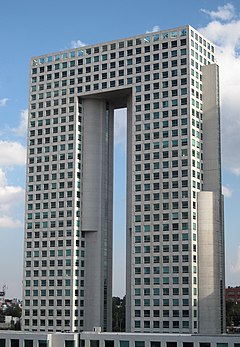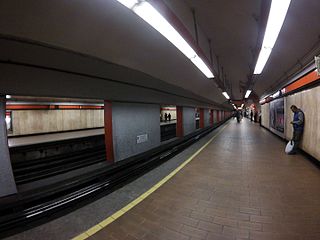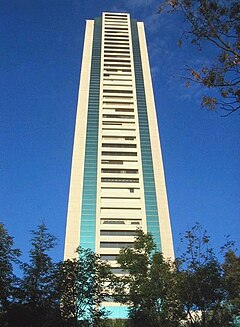 W
WMiguel Hidalgo is one of the 16 alcaldías (municipalities) into which Mexico City is divided. It was created in 1970, joining the historic areas of Tacuba, Chapultepec and Tacubaya along with a number of notable neighborhoods such as Polanco and Lomas de Chapultepec. With landmarks such as Chapultepec Park and the Museo Nacional de Antropología, it is the second most visited borough in Mexico City after Cuauhtémoc, D.F. where the historic center of Mexico City is located. Tacubaya and Tacuba both have long histories as independent settlements and were designated as “Barrios Mágicos” by the city for tourism purposes.
 W
WThe Acuario Inbursa is an aquarium in the Nuevo Polanco area of Miguel Hidalgo district, Mexico City.
 W
WAmerican Park is a park in Mexico City's Polanco neighborhood, in Mexico.
 W
WAntara Polanco, is an upscale open-air shopping center in Polanco, Mexico City, Mexico.
 W
WArcos Bosques is an office and shopping complex in Bosques de las Lomas, Cuajimalpa borough, Mexico City, Mexico, very close to the Santa Fe business district. There are two office towers, Torre I and Torre II, and a shopping center, Paseo Arcos Bosques.
 W
WMetro Auditorio is a Mexico City Metro station located on line 7. It is one of the main metro gateways to the chic and business-related neighbourhood, Polanco. The entrances to the station are on Paseo de la Reforma, one of the main thoroughfares in Mexico City.
 W
WAvenida Presidente Masaryk is a thoroughfare in the affluent Polanco neighborhood of Mexico City. It stretches from Calzada General Mariano Escobedo in the east to Avenida Ferrocarril de Cuernavaca in the west, passing along the north side of the Polanquito restaurant district that borders Parque Lincoln. Masaryk is one of the most expensive shopping districts in the world and competes with Avenida Madero in the Historic Center for the title of street with the highest rents in the city.
 W
WBosques de las Lomas is a colonia, or officially recognised neighbourhood, located in western Mexico City. It falls partly in Cuajimalpa borough and partly in Miguel Hidalgo borough.
 W
WChapultepec, more commonly called the "Bosque de Chapultepec" in Mexico City, is one of the largest city parks in the Western Hemisphere, measuring in total just over 686 hectares. Centered on a rock formation called Chapultepec Hill, one of the park's main functions is an ecological space in Greater Mexico City. It is considered the first and most important of Mexico City's "lungs", with trees that replenish oxygen to the Valley of Mexico. The park area has been inhabited and considered a landmark since the Pre-Columbian era, when it became a retreat for Aztec rulers. In the colonial period, Chapultepec Castle was built here, eventually becoming the official residence of Mexican heads of state. It would remain so until 1940, when it was moved to another part of the park called Los Pinos.
 W
WColección Jumex is a private art collection owned by Eugenio López Alonso. It includes works by Damien Hirst, Andy Warhol, Gabriel Orozco, Cy Twombly, Jeff Koons, Marcel Duchamp, Andreas Gursky, Darren Almond, Tacita Dean, Olafur Eliasson, Martin Kippenberger, Carl Hopgood, Bruce Nauman, David Ostrowski and Francis Alÿs.
 W
WConstituyentes is a station on Line 7 of the Mexico City metro on the western outskirts of the city center. It serves Chapultepec Park and numerous attractions therein, as well as the Luis Barragán House and Studio. The station opened on 23 August 1985.
 W
WLomas de Chapultepec is a colonia, or officially recognized neighborhood, located in the Miguel Hidalgo borough of Mexico City. It dates back to the 1920s, when it was founded with the name Chapultepec Heights. Home to some of the biggest mansions in the city and many high-net-worth individuals, it has gained a reputation of exclusivity. Its main entrance is through Paseo de la Reforma.
 W
WLuis Barragán House and Studio, also known as Casa Luis Barragán, is the former residence of architect Luis Barragán in Miguel Hidalgo district, Mexico City. It is owned by the Fundación de Arquitectura Tapatía and the Government of the State of Jalisco. It is now a museum exhibiting Barragán's work and is also used by visiting architects. It retains the original furniture and Barragán's personal objects. These include a mostly Mexican art collection spanning the 16th to 20th century, with works by Picasso, Diego Rivera, José Clemente Orozco, Jesús Reyes Ferreira and Miguel Covarrubias.
 W
WColección Jumex is a private art collection owned by Eugenio López Alonso. It includes works by Damien Hirst, Andy Warhol, Gabriel Orozco, Cy Twombly, Jeff Koons, Marcel Duchamp, Andreas Gursky, Darren Almond, Tacita Dean, Olafur Eliasson, Martin Kippenberger, Carl Hopgood, Bruce Nauman, David Ostrowski and Francis Alÿs.
 W
WThe Museo Soumaya is a private museum in Mexico City and a non-profit cultural institution with two museum buildings in Mexico City - Plaza Carso and Plaza Loreto. It has over 66,000 works from 30 centuries of art including sculptures from Pre-Hispanic Mesoamerica, 19th- and 20th-century Mexican art and an extensive repertoire of works by European old masters and masters of modern western art such as Auguste Rodin, Salvador Dalí, Bartolomé Esteban Murillo and Tintoretto. It is called one of the most complete collections of its kind.
 W
WThe Conservatorio Nacional de Música is a music conservatory located in the Polanco neighborhood of Mexico City, Federal District, Mexico.
 W
WNuevo Polanco is an area of Mexico City formerly consisting of warehouses and factories, bordering the upscale Polanco on the north across Avenida Ejército Nacional. Officially it consists of two colonias, Granada and Ampliación Granada.
 W
WParque Lincoln, or Lincoln Park, is a city park in Mexico City, Mexico.
 W
WParque Lira is a public park in the Tacubaya district of Mexico City, once a separate town from Mexico City. It is located on the 18th century estate of Vicente Lira. It is entered by a monumental archway designed by Italian architect Francesco Saverio Cavallari, an Italian architect who was active in Mexico 1857-1864.
 W
WPaseo de la Reforma is a wide avenue that runs diagonally across the heart of Mexico City. It was designed by Ferdinand von Rosenzweig in the 1860s and modeled after the great boulevards of Europe, such as the Ringstraße in Vienna and the Champs-Élysées in Paris. After the French intervention in Mexico overthrew the constitutional President Benito Juárez, the newly crowned Emperor Maximilian made his mark on the conquered city. He commissioned a grand avenue linking the city center with his imperial residence, Chapultepec Castle, which was then on the southwestern edge of town. The project was originally named Paseo de la Emperatriz in honor of Maximilian's consort Empress Carlota. After her return to Europe and Maximilian's subsequent execution, the restored Juárez government renamed the Paseo in honor of the Reform War.
 W
WPatriotismo is a metro station on the Mexico City Metro. It is located in both the Cuauhtémoc and Miguel Hidalgo municipalities of Mexico City. It is part of the Metro Line 9.
 W
WLos Pinos was the official residence and office of the President of Mexico from 1934 to 2018. Located in the Bosque de Chapultepec in central Mexico City, it became the presidential seat in 1934, when Gen. Lázaro Cárdenas became the first president to live there. The term Los Pinos became a metonym for the Presidency of Mexico.
 W
WPlaza Carso is a large mixed-use development in the Nuevo Polanco area of Miguel Hidalgo, Mexico City, backed by billionaire Carlos Slim. The total cost of the complex is quoted between US$800 million and 1.4 billion. The complex claims to be the largest mixed-use development in Latin America. It was built on the site of a former Vitro glass factory.
 W
WPlaza Uruguay is a park in Polanco, Mexico City, Mexico. The park features a bronze sculpture depicting José Gervasio Artigas.
 W
WMetro Polanco is a station along Line 7 of the Mexico City Metro. The station opened on 20 December 1984. It serves the Polanco neighborhood. The logo for the station features a silhouette of the clock tower of the nearby Parque Lincoln, a building typical of the architecture of Polanco.
 W
WPolanco is an affluent neighborhood in the Miguel Hidalgo borough of Mexico City. Polanco is an upscale community, famed for its luxury shopping on Avenida Presidente Masaryk, one of the most expensive streets in the Americas, as well as for the numerous prominent cultural institutions located within the neighborhood, such as the Museo Soumaya and the Colección Jumex. Polanco is often called the "Beverly Hills of Mexico", having one of the country's densest concentrations of luxury shopping, with the most Michelin star restaurants, high-net-worth individuals, upscale hotels, and diplomatic missions and embassies. Additionally, it is one of the most desirable real estate markets in Latin America.
 W
WSan Miguel Chapultepec is a colonia or neighborhood in Delegación Miguel Hidalgo in Mexico City.
 W
WTacuba is a station of the Mexico City Metro. It is located in the Tacuba district of the Miguel Hidalgo borough, to the west of downtown Mexico City. It lies along Lines 2 and 7.
 W
WTacuba is a section of northwest Mexico City. It sits on the site of ancient Tlacopan. Tacuba was an autonomous municipality until 1928, when it was incorporated into the Central Department along with the municipalities of Mexico, Tacubaya and Mixcoac. The Central Department was later split up into boroughs (delegaciones); historical Tacuba is now in the borough of Miguel Hidalgo. The area was designated as a "Barrio Mágico" by the city in 2011.
 W
WTacubaya is a working-class area of west-central Mexico City, in the borough of Miguel Hidalgo, consisting of the colonia Tacubaya proper and adjacent areas in other colonias, with San Miguel Chapultepec sección II, Observatorio, Daniel Garza and Ampliación Daniel Garza being also considered part of Tacubaya.
 W
WTacubaya is a station on Lines 1, 7 and 9 of the Mexico City Metro system. It is located in the Miguel Hidalgo municipality, west of the city centre. In 2019, the station had a total average ridership of 85,800 passengers per day, making it the fifth busiest station in the network.
 W
WTorre Altus is one of the tallest skyscrapers in Mexico City, Mexico. It is a residential condominium tower located on Paseo de los Laureles y Alcanfores in the Bosques de las Lomas district of the Miguel Hidalgo borough in the city. Bosques de las Lomas is one of the more exclusive residential and commercial districts in Latin America.